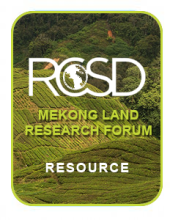/ library resources
Showing items 1 through 9 of 14.Large-scale land acquisition are not new in the Mekong region but have been encouraged and have gathered momentum since the end of the 90s, particularly Cambodia, Laos, and Myanmar.
A RESPONSE TO THE DRAFT
Research indicates that key parameters of “land grabbing” differ across regions (e.g., ILC 2012) – particularly in view of who invests and/or when the bulk of investments occurred.
Over the last decade, the highlands of Ratanakiri province in northeastern Cambodia have witnessed massive land acquisitions and profound land use changes, mostly from forest covers to rubber plantation, which has contributed to rapidly and profoundly transform the livelihoods of smallholders rel
Chongjom border is a contested area which reflects power-related relationship between center and its marginal space.
In rural Cambodia indiscriminate, illegitimate and often violent land grabs in the form of Economic Land Concessions (ELCs) have triggered myriad local responses by peasants facing evictions from private and communal lands.
The granting of economic land concessions (ELCs) over large parts of Cambodia has begun to attract global attention. It has also become a key focal point for civil society mobilization in Cambodia as well as for transnational activism directed at targets both within and outside Cambodia.
This assessment is in response to the 6th draft of the NLUP, released in May
2015, following months of public and expert consultations. It outlines some
of the key positive and negative points of the new draft. The new draft NLUP
Contents:
What is land and why is it important? ...
Why is land such a burning issue in Myanmar? ...
How is land related to debates about development?...
Is there a human right to land?...
Pagination
Land Library Search
Through our robust search engine, you can search for any item of the over 73,000 highly curated resources in the Land Library.
If you would like to find an overview of what is possible, feel free to peruse the Search Guide.


